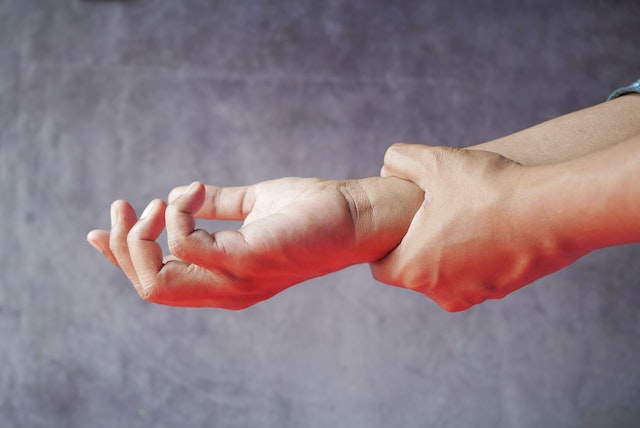
What is a sprain? It is when the ligaments around a joint are injured.
There are 350 joints in the human body, depending on what you define as a joint. We have joints that actually don’t move. These are called synarthrosis joints and their job is to give structural support. The joints between the pieces of your skull is an example of this. Then there are amphiarthrosis joints that can move a little. The joint where the fibula is attached to the tibia is an example of this. It is not rigid, because that would make it more likely to snap, but it can only move a little because it needs to be stable to support the leg. Then there are joints that move a lot and they are called diarthrosis joints. Your knee and ankle are good examples of these.
A sprain happens when a ligament is injured, so we need to look at joints that are connected with ligaments. We have over 900 ligaments in our bodies. They connect bones to bones, they hold joints together, and they keep organs where they are supposed to be. The fibula is attached to the tibia with a ligament and our liver, intestines, and stomach are held in place by ligaments. Ligaments are made of strong collagen fibers, in a tight matrix, and they come in various sizes. They are different to tendons because tendons connect muscles to bones and ligaments connect bones to bones. Ligaments are shorter than tendons, as well.
One of the greatest uses we have for ligaments is in our joints, especially the diarthrosis joints that move a lot. We have 6 types of joints that move, and they are condyloid, ball and socket, pivot, gliding, hinge, and saddle joints. Condyloid joints are in our wrists, and they allow for circular motion and extension. The shoulder is a ball and socket joint, and it can rotate in any direction. The top of the spine is a pivot joint, and it lets the head rotate. The joints in the vertebrae are gliding joints and they slide over each other. The writs and ankles have gliding joints, too. The elbow is a hinge joint, and it only has an up and down range of motion. The thumb has a saddle joint. It allows movement, but not rotation. It is thanks to this joint that we have opposable thumbs. One thing that all of these joints have in common is that they are surrounded by ligaments. For example, there are four ligaments in the knee joint that control how far the joint can move and stabilize it. Without the ligaments, the knee joint would fall apart, and it wouldn’t be able to support any weight.
Ligaments are very strong, but they are also a little bit elastic. They have to be able to stretch with the joint or else they would snap or rip off. The ligaments give the joint a range of motion, but they slow it down gradually as it reaches the limits of its motion. Ligaments and tendons are able to store elastic energy and they help us move without having to use our muscles all of the time. For example, when you walk, your muscles push your leg out, but your ligaments and tendons pull it back in again.
The ligaments can stretch, but only up to about 8% of their length. Stretching them beyond 8% is when sprains happen. If you are running and you land on the side of your foot, you might twist your ankle further than it is meant to go. If you tried to twist your foot in the same way with your hands, the ligaments would stop it moving that far, but when you step on it you are using all of your body weight and the tendons stretch. This force tears the ligaments in lots of small places. The body reacts to the tears by triggering an immune response and the joint begins to swell. The body will fix the ligaments in the space of a few days. If you can stay off your feet, they will fix faster than if you keep using the joint.
Sometimes, the ligaments are stretched beyond the point where they have small tears, and they can completely tear or become so stretched that they are loose. This quite often happens when a joint is dislocated. If you dislocate your shoulder, the joint will be pulled out of place, and it will twist and pull the ligaments as it goes. These ligaments might be detached from the bone, or they may just become longer. That means that even when the shoulder joint is put back in place, the ligaments are too loose to provide the structural support that they used to and it is far easier for the joint to dislocate again. And this is what I learned today.
Photo by Towfiqu barbhuiya: https://www.pexels.com/photo/a-person-holding-own-hand-12460181/
Sources
https://my.clevelandclinic.org/health/body/21604-ligament
https://www.betterhealth.vic.gov.au/health/conditionsandtreatments/sprains-and-strains
https://www.visiblebody.com/learn/skeleton/joints-and-ligaments
https://my.clevelandclinic.org/health/body/25137-joints
https://www.ncbi.nlm.nih.gov/books/NBK525790/
https://www.mayoclinic.org/diseases-conditions/sprains/symptoms-causes/syc-20377938
https://medlineplus.gov/ency/imagepages/19089.htm
https://web.mit.edu/tkd/stretch/stretching_3.html
https://link.springer.com/chapter/10.1007/978-0-387-73906-9_10
https://orthoinfo.aaos.org/en/diseases–conditions/chronic-shoulder-instability/
